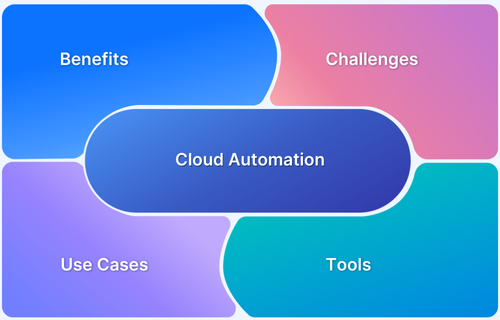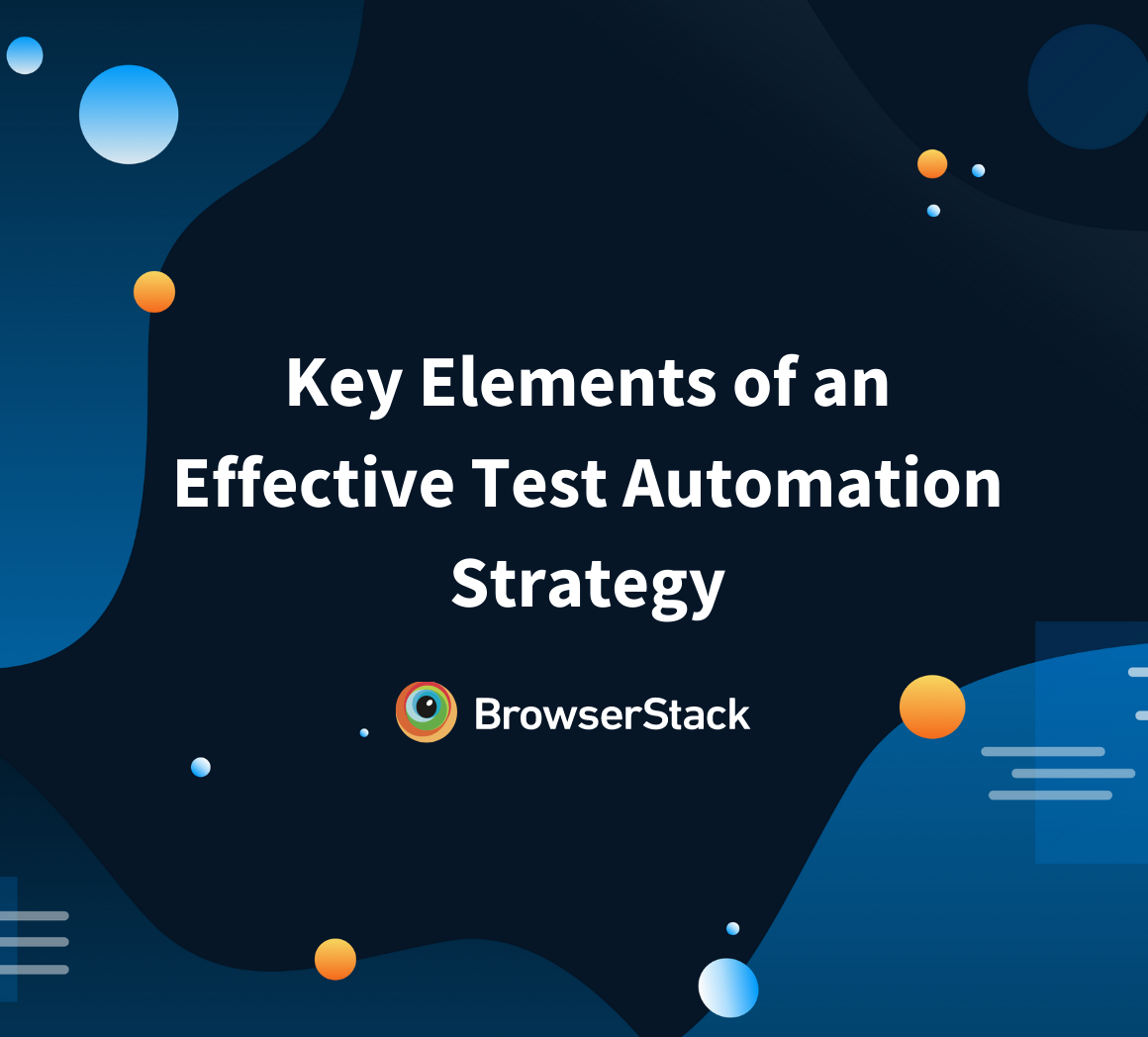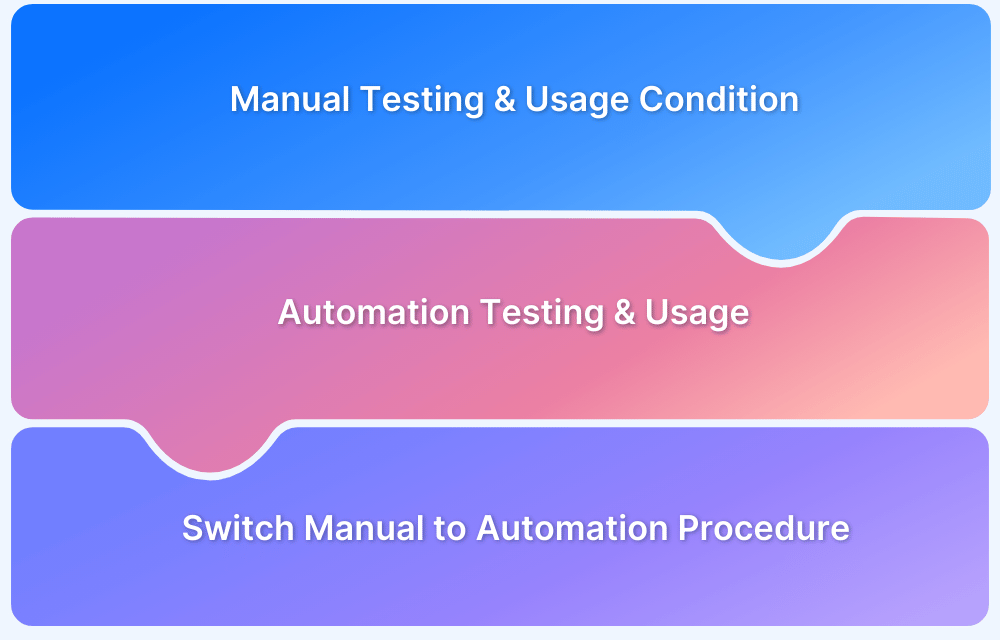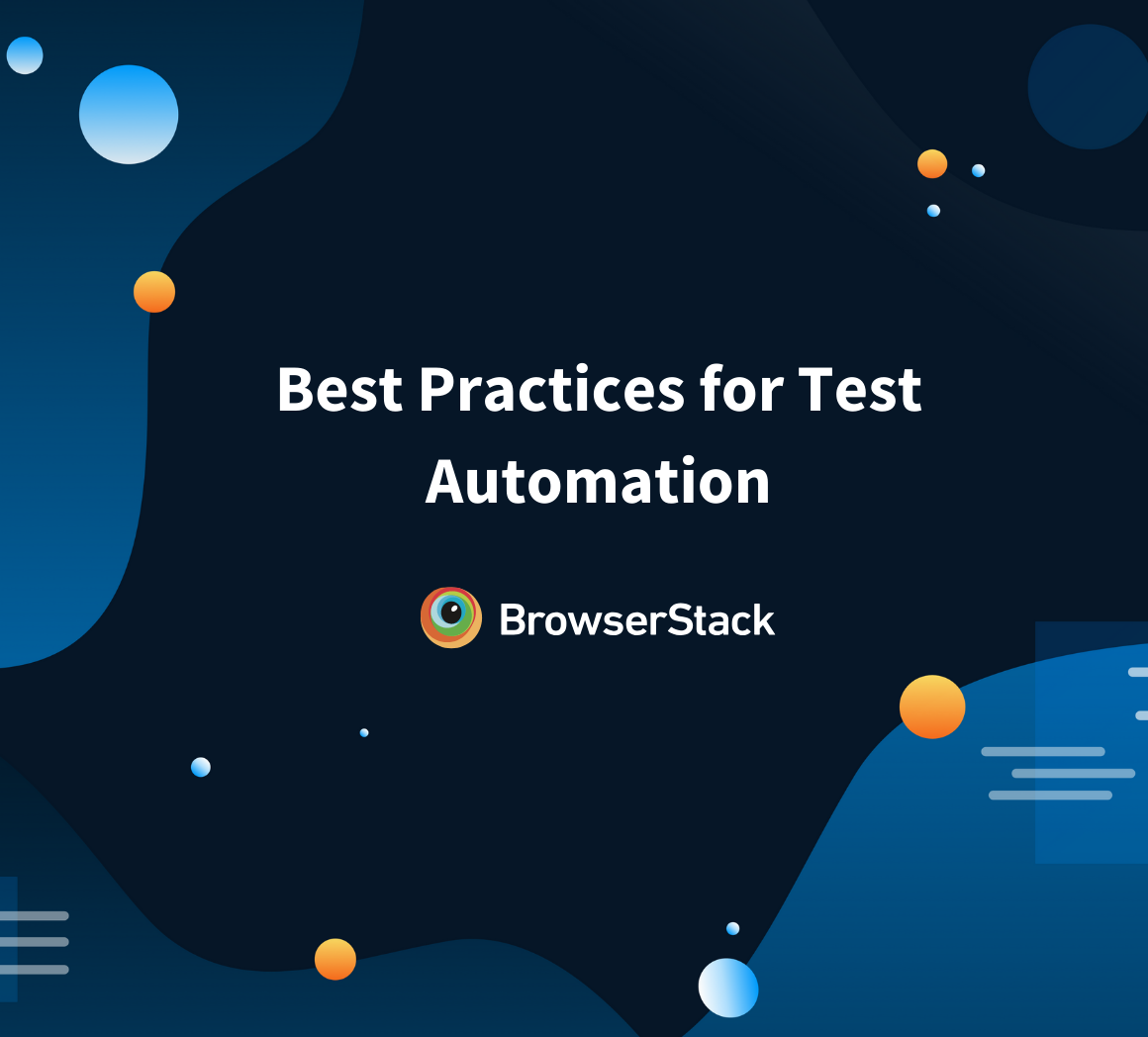Cloud automation eliminates repetitive tasks involved in managing cloud resources, ensuring faster deployments and operational efficiency. It enhances scalability, security, and cost optimization by reducing manual intervention.
Overview
What is Cloud Automation?
Cloud automation refers to using scripts and software to provision, manage, and scale cloud resources with minimal human involvement.
Key Aspects of Cloud Automation
Cloud automation encompasses various practices that enable efficient resource management, improve system reliability, and support seamless application delivery.
- Infrastructure as Code (IaC): Automates cloud infrastructure provisioning and management using machine-readable configuration files.
- Configuration Management Tools: Ensure consistent setup and maintenance of cloud environments by automating software installation, updates, and system settings.
- Continuous Integration/Continuous Delivery (CI/CD): Streamlines application development by automating code integration, testing, and deployment.
- Container Orchestration Platforms: Manage containerized applications’ deployment, scaling, and networking across cloud environments.
Common Cloud Automation Use Cases
Organizations use cloud automation to enhance efficiency, reduce costs, and improve security in various operational scenarios.
- Auto-scaling compute resources based on demand
- Deploying and updating applications without downtime
- Enforcing security policies through automated compliance checks
- Optimizing cloud costs by scheduling resource usage
- Disaster recovery through automated backups and failover mechanisms
This article explains what cloud automation is, its key benefits, different types, challenges, and tools.
What is Cloud Automation?
Cloud automation refers to using software tools and scripts to manage, deploy, and operate cloud computing environments without requiring constant manual input. It enhances efficiency, reduces human errors, and improves scalability by streamlining tasks such as provisioning resources, scaling infrastructure, and configuring networks.
Benefits of Cloud automation
Automating cloud operations brings many advantages, from speeding up deployment pipelines to reducing manual work. Below are some key benefits of cloud automation:
- Enables Continuous Deployment: Cloud automation enables continuous software releases by streamlining the testing procedure. It works with CI/CD pipelines to automatically handle build automation, testing, and deployment. This helps validate code changes quickly and release them into production.
- Reduces Errors: Manually managing cloud resources can lead to mistakes and inconsistencies. Cloud automation removes human errors by following predefined rules and policies and creating a more stable and secure system.
- Saves Time and Money: Automating cloud tasks reduces the need for manual work, lowers labor costs, and speeds up processes. Better resource management also avoids unnecessary expenses, making cloud usage more budget-friendly.
- Improves Operations: Cloud automation keeps operations smooth by automating resource setup, scaling, and continuous monitoring. It ensures resources are available when needed, prevents slowdowns, and keeps systems running reliably.
- Gives IT Teams More Time: With automation handling routine tasks, IT teams can focus on important projects, innovation, and solving complex problems instead of managing repetitive cloud operations.
- Better Tracking and Control: Cloud automation keeps a detailed record of changes, configurations, and deployments, improving tracking and control. This makes it easier to follow compliance rules, manage updates, and fix issues when needed.
Types of Cloud Automation
Cloud automation helps simplify and manage different tasks, reducing manual testing and making operations smoother. Below are the key types of cloud automation:
- Resource Allocation Automation – Autoscaling adjusts computing power, memory, and network resources based on demand. This helps manage costs while maintaining performance.
- Configuration Automation – Infrastructure-as-Code uses templates and scripts to set up infrastructure automatically. This keeps setups uniform and reduces manual mistakes.
- Development and Deployment Automation – Automates tasks like code scanning, version control, testing, and deployment, making software delivery faster.
- Tagging Automation – Automatically adds labels to cloud resources based on set rules, improving organization and cost tracking.
- Security Automation – Sets up access controls, scans for vulnerabilities, and detects threats to strengthen cloud security without manual effort.
- Logging and Monitoring Automation – Tracks activities and detects unusual behavior, making it easier to monitor systems and fix issues quickly.
Read More: What is End-to-End Monitoring?
Cloud Automation Use Cases
Cloud automation is used across various environments, including public, private, and hybrid clouds. Here are some common ways you can use cloud automation.
1. Software Development
Automating software development allows you to streamline workflows. Automation tools can integrate code changes, run tests, and deploy applications without manual work. This reduces errors, speeds up releases, and ensures consistency across environments.
2. Cloud Testing
Cloud testing lets you execute test cases simultaneously across different environments. Automated testing tools assist in identifying performance problems early, mimicking user actions, and validating software functionality, which lessens the time and effort required for testing. For instance, BrowserStack lets you execute automated parallel tests across multiple devices to speed up the testing process.
Read More: 20 Best Automation Testing Tools for Cloud
3. Setting up Infrastructure as Code (IaC)
Cloud automation enables you to specify infrastructure configurations through code. IaC tools enable you to develop templates that automatically set up cloud resources like servers, databases, and networks. Numerous cloud providers provide integrated IaC solutions to simplify your deployment process.
4. Provisioning Resources
Instead of manually assigning cloud resources, automation lets you set up dynamic provisioning. You can configure cloud automation to adjust computing power based on workload demands, helping you maintain performance while controlling costs.
5. Tracking Performance
Cloud automation helps continuously measure system performance by collecting real-time data on resource utilization, response times, and error rates. Automated monitoring tools track key performance indicators (KPIs), detect anomalies, and trigger corrective actions. Additionally, integrating performance testing within automation workflows ensures that applications can handle varying workloads and prevent bottlenecks.
Cloud Automation vs. Cloud Orchestration – Key Differences
Cloud automation and cloud orchestration might appear similar, but they have different roles. Cloud automation emphasizes managing specific activities, such as configuring resources or executing tests without human intervention. On the other hand, cloud orchestration brings multiple automated tasks together, ensuring different cloud processes work in a coordinated way.
| Feature | Cloud Automation | Cloud Orchestration |
|---|---|---|
| Definition | Automates single tasks or processes. | Automates and manages multiple processes together. |
| Scope | Focuses on repetitive, standalone tasks. | Integrates and sequences automated tasks into workflows. |
| Example Use Case | Auto-scaling a virtual machine when CPU usage increases. | Managing a software release flow, including building, testing, and deployment. |
| Complexity | Simple, task-specific automation. | More complex, involving coordination of multiple tasks. |
| Goal | Helps you reduce manual effort for individual tasks. | Ensures smooth execution of interconnected tasks. |
Read More: Best DevOps Orchestration Tool
How Does Cloud Automation Differ From Traditional IT Automation?
Cloud automation and traditional IT automation both help streamline IT operations, including resource setup, workload management, and deployment handling. The difference is that traditional IT automation focuses on on-premises systems, whereas cloud automation is designed to manage cloud environments with minimal manual intervention.
Below is a table highlighting the differences between cloud automation and traditional IT automation.
| Feature | Cloud Automation | Traditional IT Automation |
|---|---|---|
| Infrastructure | Virtual, scalable, cloud-based. | Physical, on-premises, hardware-dependent. |
| Scalability | Auto-scales based on demand. | Limited by available hardware. |
| Flexibility | Works across multiple cloud and hybrid environments. | Usually tied to specific infrastructure. |
| Implementation | Uses APIs, Infrastructure as Code (IaC), and cloud-based tools. | Relies on manual scripting and predefined workflows. |
| Cost Management | The pay-as-you-go model helps you avoid unnecessary costs. | Fixed costs with large upfront investments. |
| Maintenance | Automated updates and self-healing features. | Requires manual updates and fixes. |
What Are The Challenges In Implementing Cloud Automation?
When setting up cloud automation, you may face several challenges that need careful handling:
- Integration Complexity – Compatibility issues can make connecting automation with your existing systems, APIs, and third-party tools tricky.
- Infrastructure as Code Management – Keeping IaC templates updated and organized can become complicated, especially in large environments with frequent changes.
- Security and Access Control – Automating cloud processes can create security risks if role-based access controls and encryption are not properly set up, leading to misconfigurations or unauthorized access.
- Scalability Challenges – Although automation is intended to scale resources efficiently, improperly configured scripts may lead to bottlenecks or over-provisioning, impacting performance and expenses.
- Multi-Cloud and Hybrid Cloud Standardization – Various cloud vendors possess distinct APIs, services, and security measures, complicating the establishment of standardized automation processes.
- Automated Error Handling – If failover mechanisms are not properly set up, automated processes may fail unexpectedly, requiring strong logging, monitoring, and debugging strategies.
- Latency and Performance Optimization – Running automated workloads across different cloud environments can introduce latency, requiring fine-tuning of workflows and resource distribution.
Read More: Top 20 Performance Testing Tools
Top 5 Cloud Automation Tools
Here are the top cloud automation tools.
1. BrowserStack

BrowserStack Automate lets you run automated tests at scale on real desktop and mobile browsers. You can install the SDK for your automation testing framework and start executing tests on more than 3,500 real browser and device combinations—without making any code changes.
Key Features:
- Parallel Testing – Run thousands of tests simultaneously and reduce execution time from hours to minutes.
- Cross-Browser Testing: Test your application on over 100 browser-OS combinations to ensure it works smoothly in different environments.
- Integration with Development Workflows – Connect BrowserStack Automate with your testing workflow to trigger automated tests whenever code changes, helping you catch issues early.
- Automated Screenshot Comparison – Compare screenshots automatically to spot visual differences across browsers and devices, preventing unintended UI changes.
- Testing in Real-World Conditions – Simulate different network speeds, GPS locations, and other conditions to understand how your application performs for real users.
- Test Analytics and Reporting – Get detailed test reports, logs, and screenshots to quickly find and fix issues in your test suite.
Key benefits:
- Real User Testing – Validate compatibility on real browsers, devices, and OS versions.
- Zero Infrastructure Hassle – No need to set up or maintain test environments. Start running automated tests instantly.
- Accelerated Release Cycles – Parallel testing drastically reduces test execution time and accelerates deployment.
- Improved Test Stability – BrowserStack’s Reliable infrastructure minimizes flaky tests to ensure consistent results.
- Enhanced Product Quality – Validate performance, functionality, and user experience across real browsers, devices, and network conditions to ensure your application works seamlessly .
2. Ansible
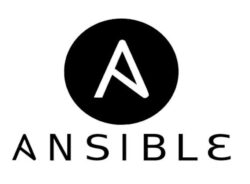
It is an open-source cloud automation platform that runs from the command line and is built using Python. It provides tools to help you configure systems, deploy software, and manage complex workflows, such as application deployment and system updates.
Key Features:
- Agentless Architecture – No need to install software on managed nodes, which reduces system load and ensuring compatibility across different environments.
- Playbook-Based Automation – Executes tasks sequentially to enable complex workflows and streamline orchestration.
- Seamless Integration – Works with Configuration Management Databases (CMDBs) and other systems for better visibility and full infrastructure control.
Key Benefits:
- Simplifies Cloud Automation – Automates setting up cloud infrastructure, deploying applications, and updating systems with minimal effort.
- Speeds Up Deployment – Handles repetitive tasks automatically, enabling faster resource provisioning and scaling.
- Enhances Reliability – Maintains consistent configurations across different test environments, reducing errors and misconfigurations.
Read More: Jenkins vs Ansible
3. Puppet

It is an open-source cloud automation tool that helps automate server configuration and management. It uses declarative language, which allows users to define system configurations by focusing on the final state rather than the steps to achieve it.
Key Features:
- Agent-Based and Agentless Modes – Supports both traditional agent-based deployment and agentless execution via Bolt for flexible automation.
- Role-Based Access Control – Provides detailed control over configuration changes, enhancing security.
- Continuous Enforcement – Ensures infrastructure stays in the desired state, reducing manual intervention and preventing drift.
Key Benefits:
- Reduces Configuration Drift – Continuously enforces the desired state to prevent misconfigurations.
- Speeds Up Deployment – Automates provisioning and configuration, cutting down manual work.
4. CircleCI

It is a cloud-based CI/CD platform that helps teams automate software development workflows. It provides a managed environment for running builds and tests. This makes it easier to set up and maintain CI/CD pipelines.
Key Features:
- SSH Debugging – Directly access and debug build issues by SSHing into any job.
- Caching Configuration – Reuse data from previous jobs by setting up caching with simple keys.
- Self-Hosted Runners – Customize platform support by configuring self-hosted runners.
- Arm Architecture Support – Access Arm VM resources and Arm on Docker for broader platform compatibility.
Key Benefits:
- Accelerates CI/CD Pipelines – Reduces build and deployment times with parallel execution and caching.
- Enhances Debugging Efficiency – Provides direct SSH access to running jobs for faster issue resolution.
- Supports Diverse Architectures – Enables development across multiple platforms, including Arm-based environments.
Read More: How to perform Test Automation with CircleCI
5. Jenkins

It is an open-source cloud automation server that helps with continuous integration and continuous deployment. It automates tasks like building, testing, and deploying software, making continuous integration and delivery easier.
Key Features:
- Flexible Automation: Works as both a CI server and a continuous delivery hub for any project.
- Easy Installation: A Java-based program that runs out of the box on Windows, Linux, and others.
- Simple Configuration: Web-based setup with real-time error checks and built-in guidance.
- Extensive Plugin Support: A large plugin ecosystem for customization and extended functionality.
Key Benefits:
- Highly Customizable: Supports various plugins to tailor automation for different project needs.
- Cross-Platform Compatibility: Runs on multiple operating systems for flexibility.
- User-Friendly Management: Web interface with built-in validation for easy setup.
- Scalable: Suitable for projects of any size, from small teams to enterprise-level deployments.
Conclusion
Cloud automation simplifies IT operations by eliminating manual tasks, reducing errors, and improving workflow. It enables continuous deployment, optimizes resources, and supports smooth expansion. By automating repetitive work, IT teams can focus on key projects while lowering costs.
Real-device testing is crucial to ensure that automated processes work seamlessly across different environments and devices. BrowserStack allows teams to test on real devices and helps them enhance performance, improve reliability, and accelerate innovation while maintaining scalability and efficiency.
